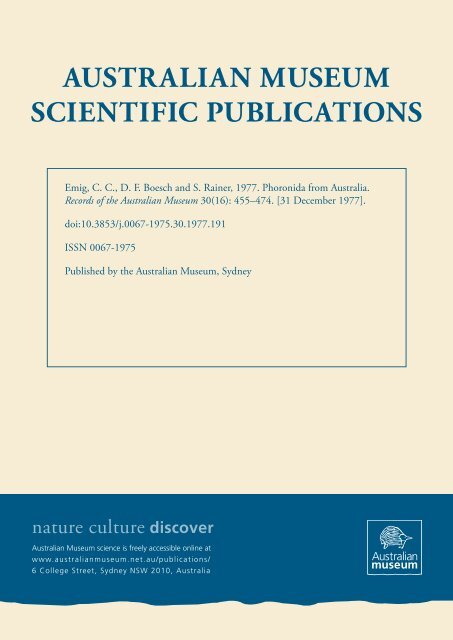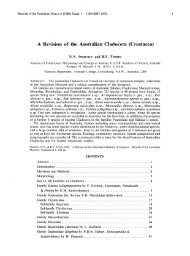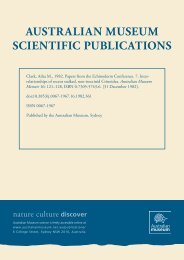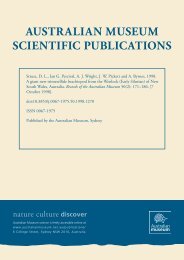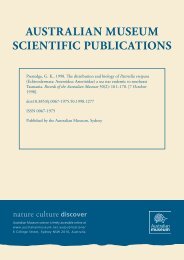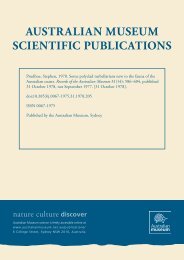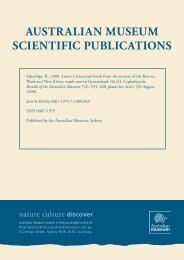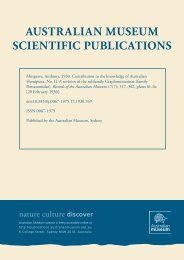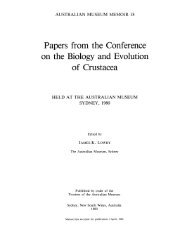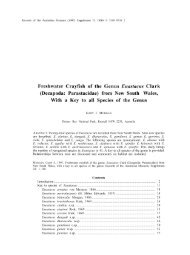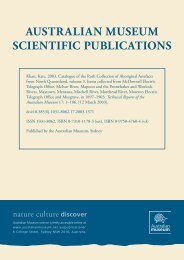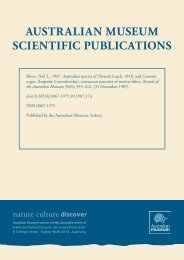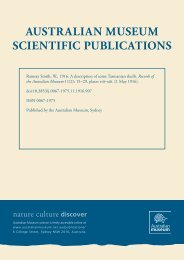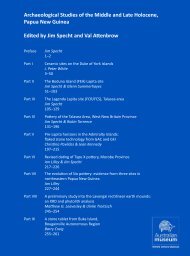Phoronida from Australia - Paleopolis
Phoronida from Australia - Paleopolis
Phoronida from Australia - Paleopolis
You also want an ePaper? Increase the reach of your titles
YUMPU automatically turns print PDFs into web optimized ePapers that Google loves.
AUSTRALIAN MUSEUM<br />
SCIENTIFIC PUBLICATIONS<br />
Emig, C. C., D. F. Boesch and S. Rainer, 1977. <strong>Phoronida</strong> <strong>from</strong> <strong>Australia</strong>.<br />
Records of the <strong>Australia</strong>n Museum 30(16): 455–474. [31 December 1977].<br />
doi:10.3853/j.0067-1975.30.1977.191<br />
ISSN 0067-1975<br />
Published by the <strong>Australia</strong>n Museum, Sydney<br />
nature culture discover<br />
<strong>Australia</strong>n Museum science is is freely accessible online at at<br />
www.australianmuseum.net.au/publications/<br />
6 College Street, Sydney NSW 2010, <strong>Australia</strong>
PHORONIDA FROM AUSTRALIA<br />
CHRISTIAN C. E'MIG<br />
Station Marine d'Endoume, Marseille, France<br />
DONALD F. BOESCH<br />
Virginia Institute of Marine Science, Gloucester Point, Virginia, U.S.A.<br />
and<br />
SEBASTIAN RAINER1<br />
Fisheries and Wildlife Division, Melbourne, Victoria, <strong>Australia</strong><br />
SUMMARY<br />
Five species of <strong>Phoronida</strong>2 have been recorded in <strong>Australia</strong>nwaters, <strong>from</strong> the vicinities<br />
of Brisbane, Sydney and Melbourne: Phoronis pa/lida, P. psammophila, P. australis,<br />
Phoronopsis albomaculata and Phoronopsis harmeri. A diagnosis for each species is given,<br />
together with notes on their taxonomy and ecology. The descriptions of three species,<br />
Phoronis pallida, P. psammophila and Phoronopsis albomaculata, have been expanded or<br />
modified. Phoronopsis albomaculata possesses nephridia with a single funnel, nottwo, and<br />
sometimes has a spiral lophophore. A new key to the species of <strong>Phoronida</strong> is provided,<br />
modifying the key established by Emig (1971).<br />
INTRODUCTION<br />
The earliest records of <strong>Phoronida</strong> in <strong>Australia</strong>n waters were by Haswell (1883, 1885,<br />
1893), <strong>from</strong> Port Jackson. Phoronis australis Haswell, 1883 was described burrowing in the<br />
tube wall of cerianthids (Coelenterata: Anthozoa), while a second species, considered to be<br />
probably Phoronis psammophila Cori, 1889 was recorded growing over empty mussel shells<br />
(Haswell, 1893). Other records of <strong>Phoronida</strong> have been of P. australis, <strong>from</strong> Port Jackson<br />
(Benham, 1889) and <strong>from</strong> Moreton Bay (Ponder, 1971).<br />
An examination of material <strong>from</strong> recent survey work has increased the number of<br />
species of <strong>Phoronida</strong> known <strong>from</strong> <strong>Australia</strong> to five2• Phoronis psammophila has been<br />
definitely identified, and <strong>Australia</strong>n records are now available for Phoronis pallida<br />
(Schneider, 1862), Phoronopsis albomaculata Gilchrist, 1907, and Phoronopsis harmeri<br />
Pixell, 1912. The occurrences of the five species in <strong>Australia</strong>n waters are discussed below,<br />
together with brief descriptions, and a key to the species is provided. Records <strong>from</strong> Port<br />
Phillip Bay, in south-eastern <strong>Australia</strong>, are given with the station designations used<br />
previo!Jsly (MMBW and FWD, 1973).<br />
1 Present address: Division of fisheries and Oceanography, Box 21, Cronulia, N.S.W. 2230, <strong>Australia</strong>.<br />
2 Recently a sixth species, Phoronis muelJeri, has been discovered <strong>from</strong> Moreton Bay, Queensland.<br />
Records of The <strong>Australia</strong>n Museum, 1977, Vol. 30 No. 16,455-474, figures 1-6
940<br />
1<br />
2<br />
456<br />
BASS STRAIT<br />
c. C. EMIG, D. F. BOESCH AND S. RAINER<br />
Fig. 1. Phoronis palJida: distribution and abundance (nos/m2) in Port Phillip Bay, Victoria.<br />
o<br />
I<br />
1<br />
5<br />
Km<br />
10<br />
I
458 c. C. EMIG, D. F. BOESCH AND S. RAINER<br />
zones<br />
2<br />
3<br />
4<br />
5<br />
G<br />
..!!!!<br />
at<br />
E<br />
...<br />
elm mlm em<br />
-3<br />
Fig. 2. Arrangement of muscles in Phoronis palJida (after Silen, 1952). elm: central longitudinal muscles;<br />
cm: circular muscle; m/m: marginal longitudinal muscle; sph: sphincter.<br />
present, the walls being covered with fine sand grains and comparatively inflexible in<br />
regions of sandy sediment. In all instances, the tube ends immediately below the ampulla in<br />
a clear, flexible, membranous bulb free of attached sediment.<br />
Salinities at the bottom in Port Phillip Bay generally range between 34%0 and 36%0.<br />
Recorded salinities in 1970-71 for areas where P. pallida occurred were 34.1-36.6%0. lower<br />
salinities occur periodically near the mouth of the Yarra R., in the north, attimes offlood. A<br />
strong salt wedge is usually present in this area, and the occurrence of P. pa/lida near the<br />
Yarra mouth may not signify tolerance of salinities markedly below 34%0. Temperatures at<br />
the bottom range <strong>from</strong> 10° to 24°.<br />
No strong relationship with any faunal association is apparent. In general, the<br />
distribution of P. pallida follows that of surface-deposit feeding molluscs in Port Phillip Bay<br />
(Poore and Rainer, 1974).<br />
DISTRIBUTION: <strong>Australia</strong> - Port Phillip Bay (Vict.); Wider distribution - Pacific and<br />
Atlantic oceans (Emig, 1973b).<br />
Figs 7-9.<br />
Abbreviations: A ascending branch, af anal funnel, ap anal papilla, cf collar fold, 0 descending branch,<br />
d diaphragm, e embryos, ep epistome, f funnel, i intestine, Igf left giant nerve fibre, IIm left lateral<br />
mesentery, 10 .Iophophore, Iv lateral vessel, mv median vessel, n nephridiopore, ng nidamental glands,<br />
np nephridial papilla, 0 ovary, oes oesophagus, of oral funnel, ollophophoral organs, pst prestomach,<br />
rgf right giant nerve fibre, rim right lateral mesentery, slv secondary lateral vessel, st stomach, t testis.
940 ••<br />
PHORONIDA FROM AUSTRALIA 465<br />
•<br />
• .e ••<br />
944 •<br />
• •<br />
e<br />
• e 906<br />
• • •<br />
• •<br />
959<br />
,6<br />
960<br />
973 .<br />
•<br />
•<br />
•<br />
965<br />
972<br />
978<br />
BASS STRAIT e 983<br />
N<br />
1<br />
0 5 10<br />
I<br />
Km<br />
Fig. 4. Phoronopsis albomaculata: distribution and abundance \nos/m2) in Port Phillip Bay, Victoria.<br />
986<br />
918<br />
,
PHORONIDA FROM AUSTRALIA<br />
Fig. 5. Brisbane River and Moreton Bay: localities at which Phoronopsis albomaculata and Phoronis<br />
australis (Ponder, 1971) have been found. (1. Quarantine Station; 2. Meeandah; 3. Bulimba; 4. New<br />
Farm Park.)<br />
Fig. 6. Diagram of a nephridium of Phoronopsis albomaculata. The dotted line indicates the possible<br />
extent of tunnel development that may occur, especially during gonad maturation (cf. Emig, 1971).<br />
Abbreviations, see figs 7-9.<br />
467
468 c. C. EMIG, D. F. BOESCH AND S. RAINER<br />
In Port Phillip Bay Phoronopsis albomacu/ata has a distribution very similar to that of<br />
Phoronis psammophila, although more extensive (fig. 4), occurring in a density of up to 30<br />
individuals/m2 in silty-sand.1t is subjectto the same range of water temperature and salinity,<br />
and has the same depth range (2-25 m). The tube is similar to that of P. psammophila.<br />
Some difficulty was experienced in differentiating Phoronopsis albomaculata <strong>from</strong><br />
Phoronis psammophila, due to their similar general morphology and overlapping<br />
longitudinal muscle formulae. The invagination diagnostic of the genus Phoronopsis is<br />
often imperfectly developed in specimens that have recently undergone asexual<br />
propagation, or are regenerating the lophophore for any other reason. Such specimens<br />
were found at most stations, but any misidentification that may have occurred would not<br />
influence the general pattern of distribution as illustrated in figure 4.<br />
In the estuary of the Brisbane River (fig. 5), Phoronopsis albomaculata was found<br />
subtidally as far upstream as New Farm Park, 22 km <strong>from</strong> the mouth, but was most abundant<br />
(up to 272/m2) at the Quarantine Station site, 7 km <strong>from</strong> the mouth. Sediments atthese sites<br />
ranged <strong>from</strong> muddy-sand at Quarantine Station to very soft mud at Bulimba and New Farm<br />
Park. Salinity at Quarantine Station is about 34%0 during much of the year, but dropped to<br />
27%0 in December, 1971, and to 10%0 in February, 1972, following a flood caused by passage<br />
of a cyclone. At New Farm Park salinity is about 30%0 during low-flow conditions, but<br />
became near 0%0 in February, 1972. No Phoronopsis albomaculata were found above<br />
Quarantine Station just after the flood. The annual temperature range in the Brisbane River<br />
is approximately 16-28°. Benthic invertebrates associated with Phoronopsis albomacu/ata in<br />
the Brisbane River include the polychaetes Prionospio sp., Heteromastus filiform is,<br />
Notomastus sp., Owenia fusiformis and Potamilla sp; the bivalve Notospisula parva, the<br />
tanaid Apseudes estuarius and the amphipod Eriopisa australiensis.<br />
DISTRIBUTION: <strong>Australia</strong> - Port Phillip Bay, Western Port (Viet.), Brisbane River (Qld);<br />
Indian and Atlantic oceans (Emig, 1973b).<br />
Phoronopsis harmeri Pixell, 1912<br />
Fig.9a-c.<br />
Phoronopsis harmeri. - Emig, 1967: 984-989, figs 1-4<br />
Phoronis pacifica Torrey, 1901: 283-288, figs 1-5.<br />
Phoronopsis viridis Hilton, 1930: 33-34, figs 1-4.<br />
Phoronopsis striata Hilton, 1930: 34-35, figs 5-9.<br />
MATERIAL: Careel Bay, Pittwater (N.S.W.), north of Sydney, lat. 151°20'E, long. 33°38'5<br />
(Aust. Mus. W6018, W6019, W6020, W6021, W6022, W6023).<br />
Wallis Lake (N.S.W.), north of Port Stephens, lat. 152°35'E, long. 32°15'5 (Aust. Mus.<br />
W4332).<br />
DIAGNOSIS: Length - 40-220 mm, diameter 0.6-4 mm. Colour in life - greenish with<br />
white-pigmented tentacles. Lophophore - spiral, with 1.5-2 coils on each side. Tentacles-<br />
100-400, length 2-5 mm. Nephridia - with two funnels each, anal smaller than oral (fig. 3b);<br />
long descending branch; nephridiopore opening on collar fold in invagination, below level<br />
of anus (fig. 3a). Giant nerve fibres - paired, diameter of left one 20-60 J.lm (fig. 3c); right<br />
giant nerve fibre present above level of right nephridium, atrophied below. Longitudinal<br />
I f I 20-48123-55 37 136<br />
musc e ormu ae - range [75-138) =<br />
d d' .<br />
12-2711-26' mealil 111 = 20 18' Gona s - 10eClOUS;<br />
lophophoral organs large, membranous; nidamental glands absent; no brooding pattern.<br />
Larval form - Actinotrocha A (Zimmer, 1964). Invagination - very distinct (fig. 9a, b).
PHORONIDA FROM AUSTRALIA<br />
Fig. 9. Phoronopsis harmeri. (a) cross section of the collar fold, through the anal papilla and the<br />
nephridiopore; (b) cross section (below a) of the descending branch and two funnels of the right<br />
nephridium; (c) cross section of the muscular region. Phoronis australis. (d) cross section of the<br />
lophophore (left spiral only), showing the anterior partofthe nidamental gland; (e) cross section ofthe<br />
nephridial papilla, with accessory sex glands in the lophophoral concavity; (f) cross section of the<br />
muscular region.<br />
469
470 c. C. EMIG, D. F. BOESCH AND S. RAINER<br />
REMARKS: The material examined agrees well with the specific characteristics of<br />
Phoronopsis harmeri. The collar fold is very distinct, with the invagination much stronger<br />
than in Phoronopsis albomacu/ata (fig. 8b, d, g; fig. 9a, b).<br />
The longitudinal muscle bundle formula was determined in six specimens:<br />
28 129 30 129 33128 31 130 3213.1 42133<br />
18 13 = 88; 18 13 = 90; 18 20 = 99; 21 18 = 100; 21 16 = 100; 20 19 = 114.<br />
The <strong>Australia</strong>n specimens, along with those recently described <strong>from</strong> the Cook Islands<br />
(Emig, 1973b) and <strong>from</strong> Marovo Lagoon (New Georgia Group, Solomon Islands:<br />
unpublished data), are smaller than Phoronopsis harmeri so far collected <strong>from</strong> the Pacific<br />
coast of North America. No gonads or other reproductive features were present in the local<br />
specimens, which may be juveniles.<br />
At Careel Bay P. harmeri was found in Zostera beds in fine mud near low tide and at<br />
Wallis Lake this species occurs in muddy sand at 6-8 m depth.<br />
DISTRIBUTION: <strong>Australia</strong>, Careel Bay, Wallis Lake (N.S.W.); Wider distribution -<br />
Pacific and Atlantic oceans (Emig, 1973b).<br />
KEY TO SPECIES OF PHORONIDA<br />
The results ofthe present study and the observations of Stancyk et al. (in press) and Emig<br />
(unpublished) concerning the nephridia and lophophore of Phoronopsis albomaculata and<br />
of Phoronis ijimai Oka have been incorporated in the key established by Emig (1971). Only<br />
the main taxonomic characters of the species are used, but all characters must be verified for<br />
the determination of a phoronid species.<br />
1. Lophophore oval or horseshoe-shaped. . . . . . . . . . . . . . . . . . . . . . . . . . . . . . . . . . . 2<br />
Lophophore spiral or helicoidal. . . . . . . . . . . . . . . . . . . . . . . . . . . . . . . . . . . . . . . . . 8<br />
2. Lophophore oval; nephridia with one funnel, descending branch absent; no<br />
lateral mesentery; burrowing habit .............................. . Phoronis ovalis<br />
Lophophore horseshoe-shaped. . . . . . . . . . . . . . . . . . . . . . . . . . . . . . .. . . . . . . . . . . 3<br />
3. Nephridia with one funnel, descending branch present; usually only<br />
left giant nerve fibre present. . . . . . . . . . . . . . . . . . . . . . . . . . . . . . . . . . . . . . . . . . . . 4<br />
Nephridia with two funnels, anal larger than oral; no invagination at base of<br />
lophophore; hermaphrodite. . . . . . . . . . . . . . . . . . . . . . . . . . . . . . . . . . . . . . . . . . . . 6<br />
4. Invagination present at base of lophophore, although often not distinct on<br />
oral side; nephridiopore opening on collar fold below anus .............. .<br />
. . . . . . . . . . . . . . . . . . . . . . . . . . . . . . . . . . . . . . . . . . . . . . . . . . . .. Phoronopsis albomaculata<br />
Invagination not present. . . . . . . . . . . . . . . . . . . . . . . .. . . . . . . . . . . . . . . . . . . . . . . . 5<br />
5. All mesenteries present; nephridiopore below anus ........ Phoronis psammophila<br />
Left lateral mesentery absent in muscular region; nephridiopore at level of<br />
anus; prebuccal and postbuccal tentacles of same length, lateral tentacles<br />
longer ....................................................... Phoronis muelleri<br />
6. Descending branch of nephridia nearly as long as ascending branch; left<br />
giant nerve fibre only; circular muscles (three sphincters) and longitudinal<br />
muscles (six zones) unusual ..................................... Phoronis pallida<br />
Descending branch of nephridia absent; nephridial papilla present; two<br />
giant nerve fibres; burrowing or encrusting habit. . . . . . . . . . . . . . . . . . . . . . . . . 7
PHORONIDA FROM AUSTRALIA 471<br />
7. Ascending branch of nephridia in two horizontal chambers; longitudinal<br />
muscle bundles nu mber 24-43 .............................. Phoronis hippocrepia<br />
Ascending branch of nephridia curved; longitudinal muscle bundle<br />
numbers 37-69 .................................................. Phoronis ijimai<br />
8. Lophophore spiral. . . . . . . . . . . . . . . . . . . . . . . . . . . . . . . . . . . . . . . . . . . . . . . . . . . . . . 9<br />
Lophophore helicoidal; nephridia with two funnels and descending branch;<br />
invagination present at base of lophophore, deep ......... Phoronopsis californica<br />
9. Invagination present at base of lophophore; right giant nerve fibre absent in<br />
muscular region; nephridia with descending branch. . . . . . . . . . . . . . . . . . . . . . 10<br />
Invagination not present; nephridia with two funnels, anal larger than oral;<br />
nephridia without descending branch; two giant nerve fibres .................. 11<br />
10. Nephridia with one funnel ............................ Phoronopsis albomaculata<br />
Nephridia with two funnels, anal smaller than oral; invagination very<br />
distinct ................................................... Phoronopsis harmeri<br />
11. Burrowing or encrusting species .................................. Phoronis ijimai<br />
I nhabitating cerianthid tube-wall; lophophore multispiral. .. Phoronis australis<br />
ACKNOWLEDGEMENTS<br />
We wish to thank N. Coleman and P. Hutchings, <strong>Australia</strong>n Museum, for their assistance<br />
in collecting material <strong>from</strong> Wreck Bay (N.e), and <strong>from</strong> Wallis Lake, Careel Bay and Camp<br />
Cove (P.H.). We are also grateful to G. Poore and R. Spies, Victorian Fisheries and Wildlife<br />
Division, for material <strong>from</strong> Port Phillip Bay.
472 c. C. EMIG, D. F. BOESCH AND S. RAINER<br />
Fig. 8. Phoronopsis albomaculata. (a) cross section of the lophophore, without accessory sex glands; (b)<br />
cross section, slightly oblique, through the funnel; (c) cross section of the lophophore through the<br />
lophophoral organs; (d) cross section (below b) of the nephridia; (e) cross section of the muscular<br />
region; (f) cross section of the ampulla, showing testis in the two oral cavities; (g) cross section of the<br />
nephridia.
PHORONIDA FROM AUSTRALIA<br />
REFERENCES<br />
Andrews, E. A., 1890. On a new American species of the remarkable animal Phoronis. Ann. Mag. nat.<br />
Hist. 5: 445-449.<br />
Benham, W. B., 1889. The anatomy of Phoronis australis. Q. JI mierosc. Sci. 30: 125-158.<br />
Emig, C. c., 1969a. Considerations sur la systematique des Phoronidiens. Ill. Phoronis psammophifa<br />
Cori, 1889, et Phoronis architecta Andrews, 1890. Buff. Mus. Hist. nat. Paris 41: 312-327.<br />
--- 1969b. Considerations sur la systematique des Phoronidiens. VIII. Phoronis paffida (Schneider)<br />
Silen, 1952. IX. Phoronis ovalis Wright, 1856. Buff. Mus. Hist. nat. Paris 41: 1531-1542.<br />
---1971. Taxonomie et systematique des Phoronidiens. Buff. Mus. Hist. nat. Paris (Zoo I.) 8 (3): 469-<br />
568.<br />
---1972. Phoronidiens recoltes lors de la campagne "Bia\ores" du N/O Jean Charcot. Tethys, Fr. 4:<br />
423-428.<br />
--- 1973a. Phoronidiens de Madagascar. Tethys, Fr., suppl. 5: 9-24.<br />
--- 1973b. Ecologie des Phoronidiens. Buff. Eeol. 4 (4): 339-364.<br />
---1974. The systematics and evolution of the phylum <strong>Phoronida</strong>. Z. zool. Syst. Forsch.-Evol. 12 (2):<br />
128-151.<br />
--- C. Herberts and B. A. Thomassin, 1972. Association de Phoronis australis (<strong>Phoronida</strong>) avec<br />
Cerianthus maua (Ceriantharia) dans les zones recifales de Madagascar. Mar. BioI. 15: 304-315.<br />
--- and I. Marche-Marchad, 1969. Considerations sur la systemati'lue des Phoronidiens. VII.<br />
Phoronis australis Haswell, 1883. Buff. Mus. Hist. nat. Paris 41: 1244-1251.<br />
--- and B. Thomassin, 1969. Considerations sur la systematique des Phoronidiens. VI. Phoronopsis<br />
albomaculata Gilchrist, 1907. Buff. Mus. Hist. nat. Paris 41: 901-908.<br />
Haswell, W. A., 1883. Preliminary note on an <strong>Australia</strong>n species of Phoronis (Gephyrea Tubieola). Proc.<br />
Linn. Soc. N.S. W. 7: 606-608.<br />
--- 1885. On a new instance of symbiosis. Proc. Linn. Soc. N.S. W. 9: 1019-1021.<br />
---1893. The occurrence of a second species of Phoronis in Port Jackson. Proc. Linn. Soc. N.S. W. (2)<br />
7: 340-341.<br />
Hilton, A. W., 1930. Phoronidea <strong>from</strong> the coast of southern California. J. Ent. Zool. 22: 33-35.<br />
Ikeda, I., 1903. On the occurrence of Phoronis australis Haswell near Misaki. Ann. Zool. Japan. 4: 115-<br />
118.<br />
MMBW and FWD, 1973. Environmental study of Port Phillip Bay, report on phase one, 1968-1971.<br />
Melbourne and Metropolitan Board of Works and Fisheries and Wildlife Department of Victoria,<br />
Melbourne, 372 pp.<br />
Ponder, W. F., 1971. "Montacutona ceriantha" n. sp., a commensal lepton id bivalve living with<br />
"Cerianthus". J. Conch. Paris 109: 15-25.<br />
Poore, G. C. B., and S. F. Rainer, 1974. Distribution and abundance of soft-bottom molluscs in Port<br />
Phillip Bay, Victoria, <strong>Australia</strong>. Aust. J. mar. Freshwat. Res. 25 (3): 371-411.<br />
Roule, L., 1889. Sur une nouvelle espece mediterraneenne du genre Phoronis. C. r. hebd. Seanc. Acad.<br />
Sci., Paris 109: 195-196.<br />
Selys-Longchamps, M. De., 1907. Phoronis. Fauna Flora, Golf Neapel, 30: 1-280.<br />
Silen, L., 1952. Research on Phoronidea of the Gullmar Fiord area (west coast of Sweden). Ark. Zool. 4<br />
(4): 95-140.<br />
473
474 c. C. EMIG, D. F. BOESCH AND S. RAINER<br />
Stancyk, S. E., F. J. S. Maturo and R. W. Heard, 1976 Phoronids <strong>from</strong> the east coast of the United States.<br />
Bull. mar. Sci. 26(4): 576-584.<br />
Torrey, H. B., 1901. On Phoronis pacifica sp. novo Bioi. Bull. mar. bioi. Lab., Woods Hole 2: 283-288.<br />
Zimmer, R. L., 1964. Reproductive biology and development of <strong>Phoronida</strong>. Univ. Microfilm, Ann Arbor,<br />
416pp.<br />
APPENDIX<br />
Recently, P. australis, Phoronopsis harmeri, Phoronopsis albomaculata, and a species<br />
new to <strong>Australia</strong>n waters, Phordnis muelleri have been discovered near Peel Island and<br />
Middle Banks (Moreton Bay). pata on these specimens will be published later.<br />
Manuscript accepted for publication 1 July, 1974


